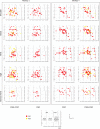Forelimb muscle representations and output properties of motor areas in the mesial wall of rhesus macaques
- PMID: 19633176
- PMCID: PMC2820706
- DOI: 10.1093/cercor/bhp136
Forelimb muscle representations and output properties of motor areas in the mesial wall of rhesus macaques
Abstract
In this study, forelimb organizations and output properties of the supplementary motor area (SMA) and the dorsal cingulate motor area (CMAd) were assessed and compared with primary motor cortex (M1). Stimulus-triggered averages of electromyographic activity from 24 muscles of the forelimb were computed from layer V sites of 2 rhesus monkeys performing a reach-to-grasp task. No clear segregation of the forelimb representation of proximal and distal muscles was found in SMA. In CMAd, sites producing poststimulus effects in proximal muscles tended to be located caudal to distal muscle sites, although the number of effects was limited. For both SMA and CMAd, facilitation effects were more prevalent in distal than in proximal muscles. At an intensity of 60 microA, the mean latencies of M1 facilitation effects were 8 and 12.1 ms shorter and the magnitudes approximately 10 times greater than those from SMA and CMAd. Our results show that corticospinal neurons in SMA and CMAd provide relatively weak input to spinal motoneurons compared with the robust effects from M1. However, a small number of facilitation effects from SMA and CMAd had latencies as short as the shortest ones from M1 suggesting a minimum linkage to motoneurons as direct as that from M1.
Figures








References
-
- Akazawa T, Tokuno H, Nambu A, Hamada I, Ito Y, Ikeuchi Y, Imanishi M, Hasegawa N, Hatanaka N, Takada M. A cortical motor region that represents the cutaneous back muscles in the macaque monkey. Neurosci Lett. 2000;282:125–128. - PubMed
-
- Akkal D, Bioulac B, Audin J, Burbaud P. Comparison of neuronal activity in the rostral supplementary and cingulate motor areas during a task with cognitive and motor demands. Eur J Neurosci. 2002;15:887–904. - PubMed
-
- Asanuma H, Rosen I. Topographical organization of cortical efferent zones projecting to distal forelimb muscles in the monkey. Exp Brain Res. 1972;14:243–256. - PubMed
-
- Belhaj-Saif A, Karrer JH, Cheney PD. Distribution and characteristics of poststimulus effects in proximal and distal forelimb muscles from red nucleus in the monkey. J Neurophysiol. 1998;79:1777–1789. - PubMed
-
- Boudrias MH, Belhaj-Saif A, Park MC, Cheney PD. Contrasting properties of motor output from the supplementary motor area and primary motor cortex in rhesus macaques. Cereb Cortex. 2006;16:632–638. - PubMed

